




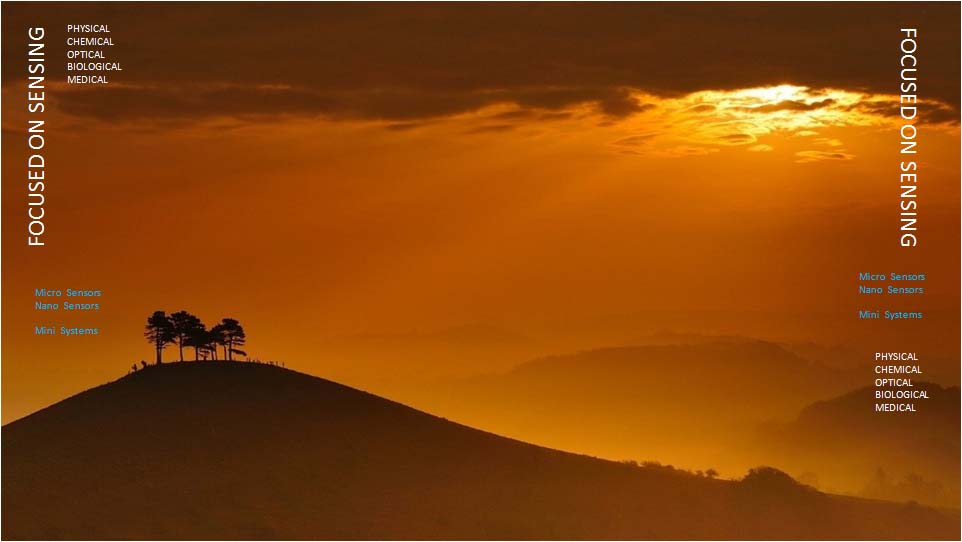

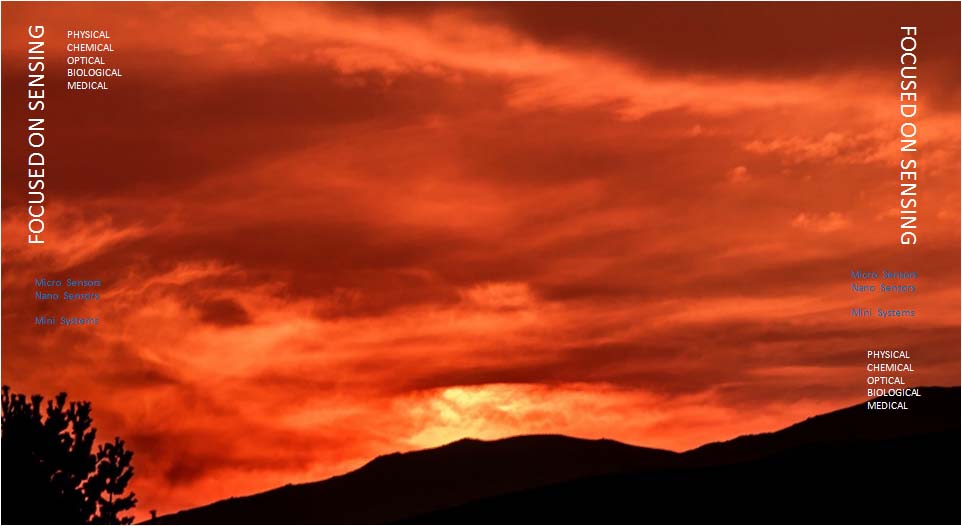



A single sensor should always provide the same output for a given input. This page shows some examples of Waddan's sensors depending on the type of measurands.
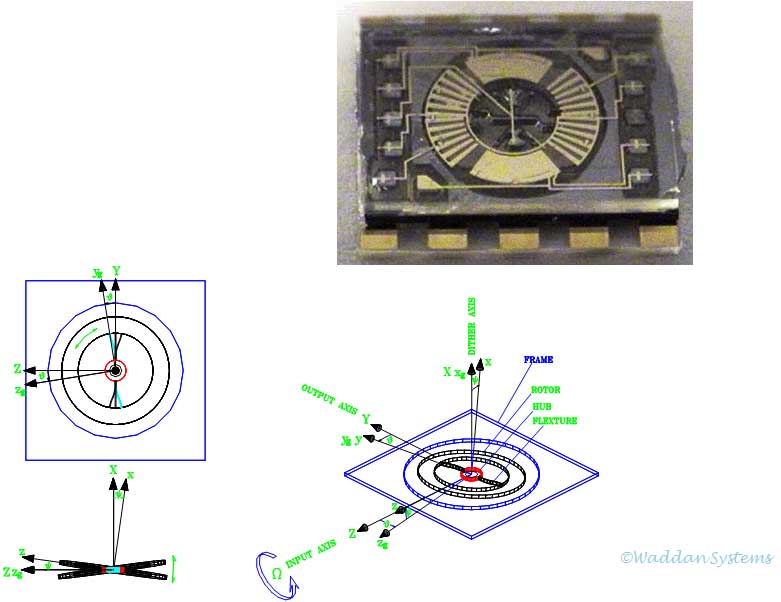 Based upon Newton's Laws, these devices provide autonomous measurement of linear acceleration
and angular rate measurements. These are used in inertial navigation systems (INS). The
velocity and position of a vehicle is determined by first and second integral of accelerometer
output, and the heading determination of the vehicle additionally requires the integration of
the rate gyro output (in a strapdown INS). The above picture shows our two gimbal rotary gyro
used for measuring angular rate. Its principle of operation is also illustrated. Its input
axis lies in the plane of the substrate
Based upon Newton's Laws, these devices provide autonomous measurement of linear acceleration
and angular rate measurements. These are used in inertial navigation systems (INS). The
velocity and position of a vehicle is determined by first and second integral of accelerometer
output, and the heading determination of the vehicle additionally requires the integration of
the rate gyro output (in a strapdown INS). The above picture shows our two gimbal rotary gyro
used for measuring angular rate. Its principle of operation is also illustrated. Its input
axis lies in the plane of the substrate
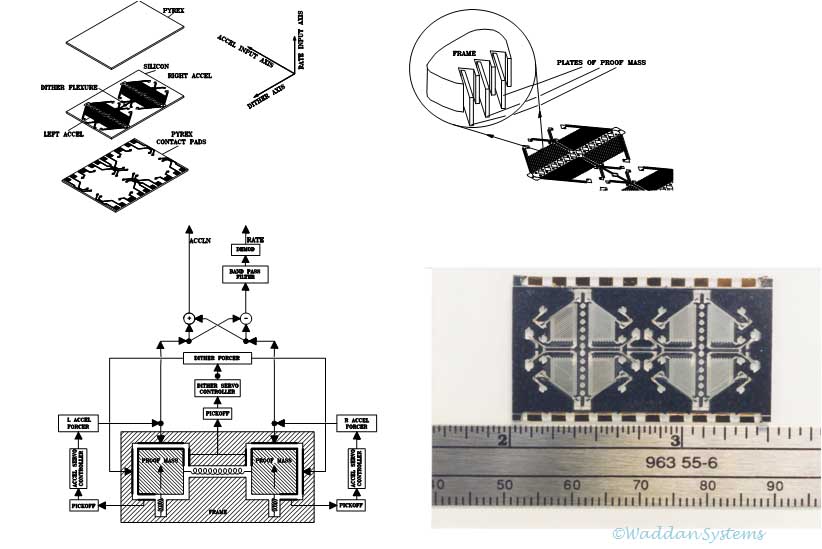
A multi-sensor has two or more devices cofabricated. A pair of accelerometers and their dithering structure are all made together in a single device. The two masses are suspended independently to act as accelerometers, and also tied to each other with an intermediate spring. A 180 deg out of phase side excitation drives the two masses and the intermediate spring into resonance to produce equal and opposite side velocity. This device measures sum and difference of applied linear acceleration and coriolis acceleration due to angular rate normal to the device. The device and its operational principle are shown in the above picture.
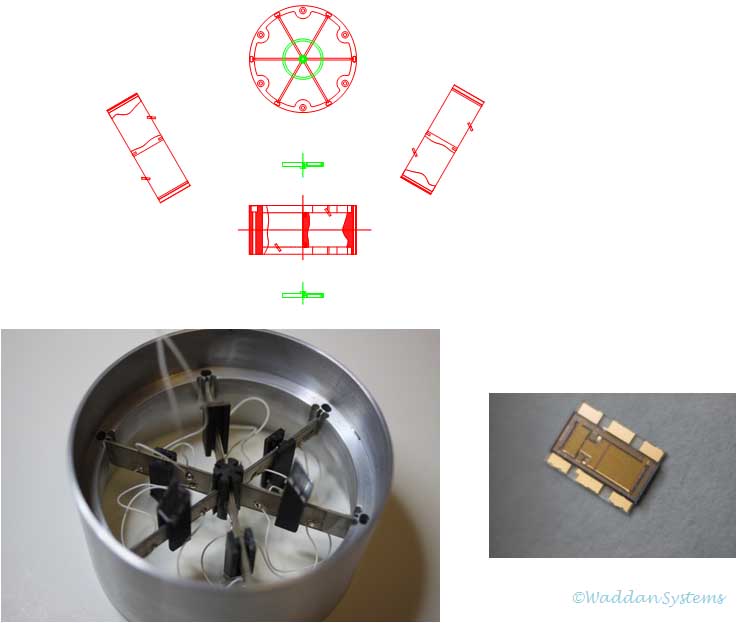 The instrument cluster shown is mechanized as a dither web IMU. There are six simply
supported beams, each has a WISA mounted at its mid-point (location of highest lateral
displacement). The devices are mounted at such an angle that their input axes form an
orthogonal triad. The instrument cluster yields 3D vector measurements of linear
acceleration and angular rate.
The instrument cluster shown is mechanized as a dither web IMU. There are six simply
supported beams, each has a WISA mounted at its mid-point (location of highest lateral
displacement). The devices are mounted at such an angle that their input axes form an
orthogonal triad. The instrument cluster yields 3D vector measurements of linear
acceleration and angular rate.
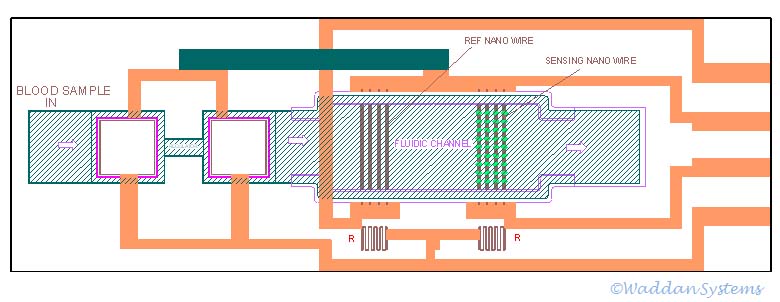
The device shown is a disposable silicon carbide nanowire biochip. The presence of biomolecules is detected by the changes in the balance of a biomarker specific Wheatstone bridge embedded in the device. The device structure shows a micro-pump for regulating the blood flow through through the fluidic channel. The sensing leg of the bridge has nanowires covered with antibody receptors and the reference leg has no receptor antibodies. When the blood passing through the channel contains PSA antigens, they bind covalently with the antibodies on the sensing leg nanowires, thereby changing their electrical conductivity. This causes an imbalance in the bridge which is easily measured across the bridge as the differential output between the two middle pads.
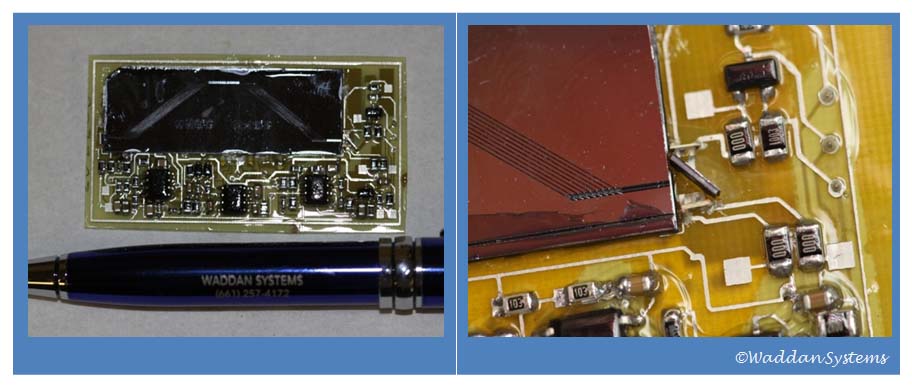
The laser based gas detection employs a basic fact that gases absorb optical radiation at unique wavelengths. These spectral gas absorption lines are very narrow and sharp. If a laser radiating at a central wavelength close to the absorption line of a gas is modulated such that its output wavelength is scanned across the absorption line of the gas, then in the presence of the gas the laser radiation is proportionally absorbed. A detector measuring the laser output measures reduced intensity every time the laser output wavelength coincides with that of gas absorption line. If the laser is modulated at a frequency f, the laser wavelength scans across the gas absorption line twice in each cycle; thus the gas detection information is available at 2f frequency. The amplitude of the absorption signal is proportional to the level of gas distribution through which the laser light passes before being detected by the detector.
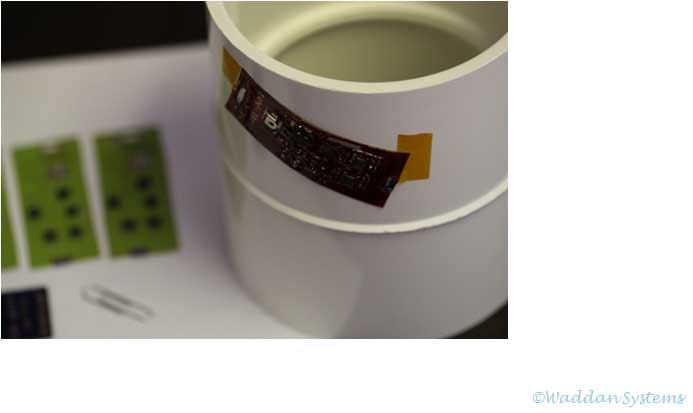 This flex board package shown above incorporates an integrated sensor array for vibration,
pressure, temperature and strain measurements; a low power microcontroller and a ZigBee
transceiver. The microcontroller employed has an 8-channel embedded AtoD converter which
allows interfacing with sensor array. The sensor array is an integrally fabricated die
using Waddan Systems' bulk micromachining technology.
This flex board package shown above incorporates an integrated sensor array for vibration,
pressure, temperature and strain measurements; a low power microcontroller and a ZigBee
transceiver. The microcontroller employed has an 8-channel embedded AtoD converter which
allows interfacing with sensor array. The sensor array is an integrally fabricated die
using Waddan Systems' bulk micromachining technology.
 The devices
shown here are surface micromachined devices plated with electroless nickel. The simplest
device is an optical switch controlling the reflected beam on or off depending upon a digital
voltage input. The top photo shows a variable focus concave mirror. The bottom photo shows a
two gimbal mirror for steering the incident beam anywhere within a 10 degree solid cone.
The devices
shown here are surface micromachined devices plated with electroless nickel. The simplest
device is an optical switch controlling the reflected beam on or off depending upon a digital
voltage input. The top photo shows a variable focus concave mirror. The bottom photo shows a
two gimbal mirror for steering the incident beam anywhere within a 10 degree solid cone.
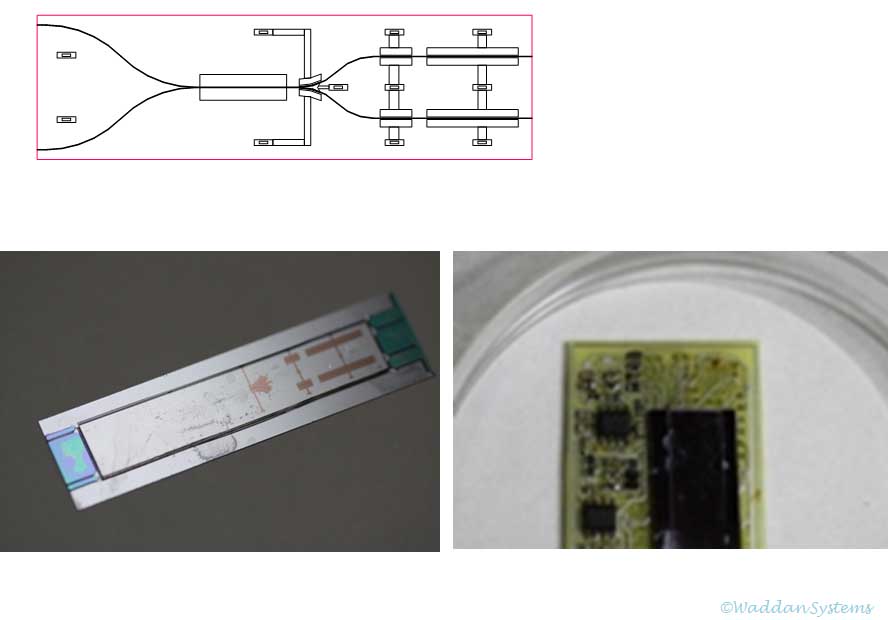
The MIOC shown above consists of a sandwich of LiNbO3 and silicon substrates, bonded together via strain relieved posts which also serve as ohmic contacts between the optical and electronics partitions. All the optical waveguides are built on the LiNbO3 chip The silicon substrate has the V-grooves built-in to align the fiber ends from the spool with the waveguides on the for the IOC chip. The design incorporates a high degree of operational symmetry in optical, mechanical and electronic areas. The reciprocal configuration ensures a stable bias. The gyro operation at the highest point of sensitivity is ensured via a differential bias phase modulator (DBPM) that precisely tracks the wave propagation time along the total length of the fiber spool. For the closed-loop operation, a digitally synthesized phase ramp generator nulls the rotation rate induced Sagnac phase shift via a differential Sagnac phase modulator (DSPM).
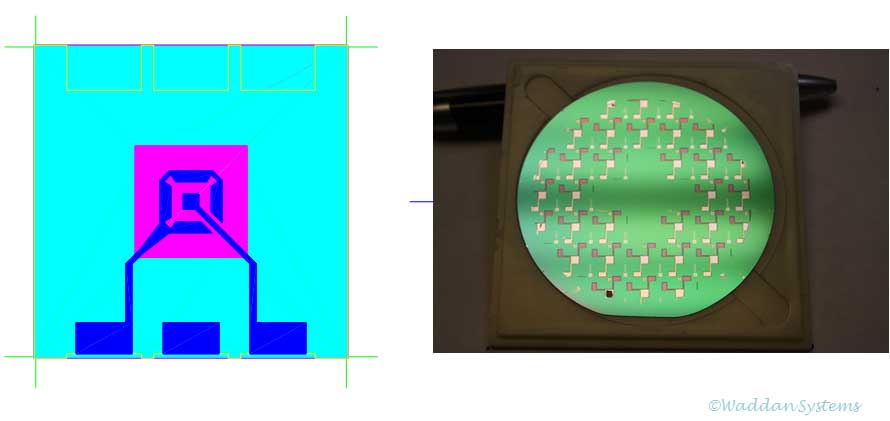 Hydrophones are basically underwater sound recording devices. When the sound travels under water,
it produces pressure waves that can be sensed by the flexing of a diaphragm placed in that water.
Waddan's hydrophone employs a stack of piezoelectric films strategically placed on the diaphragm ,
and when the diaphragm flexes due to pressure changes that produces electrical signal.
Waddan's hydrophone is a doublet device-constructed on both sides of a wafer midplane
symmetric diaphragm. Essentially two hydrophones placed back to back producing identical
but 180 degree out of phase signals. This differential measurement removes the most
effects of variable like temperature, depth etc. For directivity of sound waves, Waddan
also has 2D array of these devices collocated on the same chip. Current devices are built
with either Boron/ZnO/Aluminum or Aluminum/ZnO/Aluminum piezoelectric stack.
Hydrophones are basically underwater sound recording devices. When the sound travels under water,
it produces pressure waves that can be sensed by the flexing of a diaphragm placed in that water.
Waddan's hydrophone employs a stack of piezoelectric films strategically placed on the diaphragm ,
and when the diaphragm flexes due to pressure changes that produces electrical signal.
Waddan's hydrophone is a doublet device-constructed on both sides of a wafer midplane
symmetric diaphragm. Essentially two hydrophones placed back to back producing identical
but 180 degree out of phase signals. This differential measurement removes the most
effects of variable like temperature, depth etc. For directivity of sound waves, Waddan
also has 2D array of these devices collocated on the same chip. Current devices are built
with either Boron/ZnO/Aluminum or Aluminum/ZnO/Aluminum piezoelectric stack.
